
Immaculate Echinocactus polycephalus seedling
Back in 2009 I bought 100 seeds each of Echinocactus polycephalus (SNL 91; Las Vegas, Nevada) and Echinocactus horizonthalonius (SB 409; Shafter, Texas) from Mesa Garden. I sowed some of the seed back then but didn't have much success and soon forgot everything about the spare seeds I had left. That is until a few days ago :-)
As the seeds, in my (limited) experience, are extremely hard to germinate I decided to scarify them with a scalpel. You have to be very careful not to damage the embryo when making shallow cuts in the testa (seed coat) with a scalpel - and manually scarifying 80-some tiny seeds is an extreme test of your patience. After brutally cleaving several seed embryos I settled for chipping away at the protrusion of the hilum - this allowed me to break of small pieces of the testa without damaging the embryo within. The scarified seeds were left to soak in water for a few hours - I added the smallest tad of detergent to remove the water surface tension and allow for more efficient soaking of the seeds.
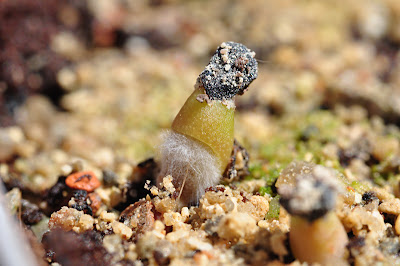
Echinocactus polycephalus seedling in the process of damping off - killed by mold
A few days after sowing the seeds several seedlings have surfaced. Unfortunately a few of them are already showing "rusty" spots and some has completely damped off, killed by mold. Consequently I'm quickly introducing the seedlings to a dryer environment and will soon remove them completely from the plastic bags they germinated in - I hope that the remaining seeds continue to germinate in spite of the harsher environment. Steve Brack's encouraging notes regarding this type of cacti reads: "rot easily, right after germination: not too wet, dry air and stronger light."

Etiolated Echinocactus polycephalus seedling, red from the sun
Some of the seedlings seem to have a hard time ridding themselves of the spent seed coat. They grow slightly etiolated and don't develop much chlorophyl in the deep shade of the testa - consequently they turn all red when exposed to the sunlight.

Echinocactus polycephalus seedling showing "rusty" spots
As usual I'm germinating my seeds in pots placed in clear plastic bags. As it's early summer I'm experimenting with germinating the seeds outdoors on the balcony - the daytime temperatures are around 20 C (68 F) with pleasantly cool nights. The temperature inside the bags off course grow hotter as they are exposed to sun during the day.

Bags containing Echinocactus, Ariocarpus, Aztekium, and peyote seedlings
With time I hope that my seedlings grow to look like this beautiful cluster of Echinocactus polycephalus (var. xeranthemoides) that overlooks the Tonto Platform in the Grand Canyon

Echinocactus polycephalus (var. xeranthemoides) overlooking the Tonto Platform
The Echinocactus horizonthalonius seedlings seem somewhat easier and more "well behaved". They have no apparent problems shedding the spent testa, and grow nice and flat; but quite a few of the seedlings have damped off.

Echinocactus horizonthalonius seedling

Echinocactus horizonthalonius seedling ridding itself of the spent seed coat
It's probably not going to be in my lifetime, but I hope my seedlings will grow to look like the fine specimen featured at the Chrudimský Kaktusář web site:

Flowering Echinocactus horizonthalonius
Tuesday, June 25, 2013
Growing Echinocactus polycephalus and Echinocactus horizonthalonius from seed
Saturday, April 05, 2008
Starting Pelecyphora and Lophophora from seed, 2008
Yesterday I started this year’s first batch of seed. I’m usally sowing my cactus seeds at the beginning of March, but I’ve been otherwise occupied so I had to start a bit later than usual. 30 seeds each of the following species were sown:
- Lophophora williamsii (SB 418; Presidio County, Texas)
- Pelecyphora aselliformis (MMR 111.1; El Pedernal, San Luis Potosí, Mexico)

Lophophora williamsii, Shafter, Presidio County, Texas (photo from http://lophophora.info/)
I’ve been looking for L. williamsii originating from the Trans-Pecos region of Texas for a while, so I was pretty exited to find the SB418 seeds from Presidio County, Texas. I’m looking forward to see how these plants develop (and also bought a batch of these seeds to start in my coldhouse).

Pelecyphora aselliformis in habitat (photo from http://www.cact.cz/)
Pelecyphora aselliformis is a first for me. I’ve always wanted to grow this distinctive species but for some reason never got around to it until now.
The seeds were started as described in the post on growing cactus from seeds and are bought from Jan Martin Jecminek.
Most of the seeds I’m growing this year have been selected for their (alleged;-) cold hardiness and will be sown later in my unheated greenhouse.
Update - April 12, 2008
Prompted by Patrick's comment I decided to include more detailed information on how the germination progresses. 5 days after sowing the seeds one Lophophora and 8 Pelecyphora seedlings had germinated (L=1/P=8). After 6 days the numbers were L=6/P=14, after 7 days L=13/P=17, and today (day 8) L=15/P=20. This means that after 8 days the germination rates for the Lophophora and Pelecyphora seeds are respectively 50% and 67%.
Update - April 25, 2008
April 19 the germination numbers were L=16/P=24, on April 22 the Lophophora germination count had risen to 19, and today April 25 the counts still are L=19/P=24. So after approximately 3 weeks the germination rates for the Lophophora and Pelecyphora seeds are respectively 63% and 80%. It should be mentioned that one of the Lophophora seedlings died off but is still included in the germination count (as it actually started growing but didn't make it from there).
Monday, March 05, 2007
Seed starting Lophophora, Ariocarpus, and Epithelantha
The last couple of days I’ve been busy starting the next generation of plants from seed. One of the more interesting lophs this year is a variety of Lophophora williamsii originating from El Oso, Coahuila, Mexico. According to The genus Lophophora – Kaktusy Special 2, 2005 this variety forms massive clusters with individual heads measuring up to 15 cm (5.9'') in diameter! Unfortunately it seems the El Oso site is severely threatened by agricultural activities.

Lophophora williamsii - El Oso, Coahuila (picture taken from The genus Lophophora – Kaktusy Special 2, 2005)
I’ve sown the following Lophophora seeds this year:
- Lophophora diffusa v. koehresii (RS 1182; El Sabino, San Luis Potosí)
- Lophophora diffusa ssp. kubesai (JJH 0010892; Puente Mezquitio, Querétaro)
- Lophophora fricii (RS 404B; Viesca, Coahuila)
- Lophophora williamsii (MMR 89; El Oso, Coahuila)
- Lophophora williamsii (RS 428A; Cuatro Ciénegas, Coahuila)
 Lophophora diffusa ssp. kubesai
In addition to the Lophophora seeds I also started a handful of Ariocarpus from seed:
Lophophora diffusa ssp. kubesai
In addition to the Lophophora seeds I also started a handful of Ariocarpus from seed:
- Ariocarpus fissuratus (JDL 26; Hot Springs, Big Bend, Texas)
- Ariocarpus fissuratus (VVZ 204; Terlingua, Texas)
- Ariocarpus fissuratus (VVZ 205; North of Alpine Texas)
- Ariocarpus kotschoubeyanus v. macdowellii (RS 134; Hipolito, Coahuila)
- Epithelantha micromeris (JM 101; Sitting Bull Canyon, New Mexico)
- Epithelantha micromeris v. gregii (MMR 179; El Oso, Coahuila)
Tuesday, February 28, 2006
Lophophora williamsii and Obregonia denegrii from seed
Today I sowed this years first batch of seeds - 30 each of:
- Lophophora williamsii (VM 305k; Sierra de la Paila, Coahuila)
- Lophophora williamsii (VM 183k; Hipolito, Coahuila)
- Obregonia denegrii v. prerovskyana nom. prov. (KMR 38; Cinco de Mayo, Tamaulipas)
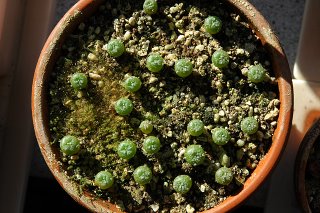 Lophophora williamsii seedlings (RS 428A; Cuatro Ciénegas, Coahuila)
It's amazing that cactus seedlings can thrive for a year in the humid environment of a sowing bag (notice the green stuff among the seedlings - it's moss!), but it seems to become them well.
Lophophora williamsii seedlings (RS 428A; Cuatro Ciénegas, Coahuila)
It's amazing that cactus seedlings can thrive for a year in the humid environment of a sowing bag (notice the green stuff among the seedlings - it's moss!), but it seems to become them well.
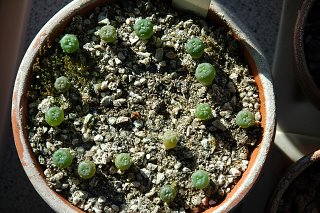 Lophophora diffusa seedlings (RS 1193; Peña Miller, Queretaro)
The benefits of growing in bags are many, e.g. you don't need to water often and most pests like red spider mites are avoided (on the other hand you have to be careful not to let in sciarid flies). On the downside, the plants seem slightly leggy - probably because they haven't been fully dormant throughout winter.
Lophophora diffusa seedlings (RS 1193; Peña Miller, Queretaro)
The benefits of growing in bags are many, e.g. you don't need to water often and most pests like red spider mites are avoided (on the other hand you have to be careful not to let in sciarid flies). On the downside, the plants seem slightly leggy - probably because they haven't been fully dormant throughout winter.
Thursday, February 09, 2006
Strombocactus Carnage or: How I Opened the Bag and Let in Death by Sciarid Fly
Until lately my Strombocactus disciformis ssp. esperanzae seedlings were thriving and slowly growing in the safe and secluded environment of a plastic bag. Recently I checked the plants and found dried husks and seedlings without roots.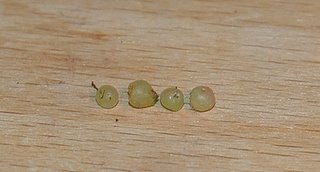
Strombocactus disciformis remains
When I opened the bag a couple of sciarid flies soared out. The soil was sterilized before use so I expect the flies must have entered one of the times I aired the bag.
Sciarid fly (fungus gnat)
Sciarid flies as such are not dangerous to the plant but their larvae will feed on root hairs, enter the roots or even attack the crown or stem of the plant. In the future I’ll take heed when airing my seedling bags and avoid organic material in the soil (the larvae of most species are scavengers, primarily feeding on decaying organic matter).
Today only one seedling is still alive and it is not doing well – the few seedlings surviving the attack also had to cope with the abrupt introduction to the harsh environment outside the bag (the soil had to dry out completely to kill off any remaining larvae).
Monday, August 22, 2005
Obregonia and Ariocarpus from seed – IV
The sowing bags have been open for the last week, and yesterday the seedling plants were removed from the bags and fully exposed to the real world environment. The 30+ Obregonia denegrii (VVZ 163; San Vicente, Tamaulipas) seedlings are growing vigorously, and I’m already wondering how to find room for all the plants ;-)
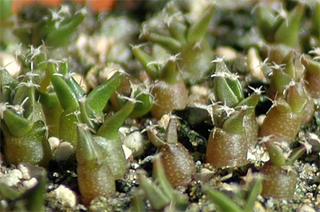
Obregonia denegrii seedlings
The 6 Ariocarpus fissuratus (PP 176; Big Bend, Texas) seedlings also started out convincingly but after growing a couple of diminutive tubercles each, their growth grinded to a halt. I’m a bit disappointed with the germination rate of these A. fissuratus seeds and will probably try again next year with seeds from a different supplier.
< previous |
Sunday, July 24, 2005
Sowing in the rough - III
I’m not sure if it’s the seed, the coldhouse environment or sheer coincidence, but in addition to the deviating growth forms described in an earlier post one of the Lophophora williamsii (SB 854; Starr Co, Texas) seedlings turned out achlorophyllous.
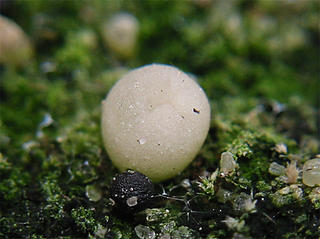
Achlorophyllous Lophophora williamsii
The seedling lacks chlorophyll and will not survive on its own roots for long so I grafted it on Pereskiopsis spathulata – hopefully it will survive and prosper.
< previous |
Saturday, May 14, 2005
Sowing in the rough
If I don’t chicken out, the plants growing from the seeds sown today are going to spend the rest of their lives in an unheated greenhouse in Denmark. 30 seeds of each of the below species were sown.
- Acharagma aguirreana (RSM 396; Sierra Paila, Coahuila)
- Acharagma roseana (LX 578; Ramon Arizpe, Coahuila)
- Lophophora williamsii v.decipiens
- Lophophora williamsii (RS 268; Huizache, San Luis Potosí)
I also sowed some leftovers from last year. 10 seeds each of:
- Lophophora diffusa (JR; Higuerillas, Queretaro)
- Lophophora williamsii (SB 854; Starr Co, Texas)
A cold house batch of the two latter species was also sowed last spring. Most plants survived the winter and are now resuming growth.
| next >
Monday, April 04, 2005
Strombocactus from seed - III
My Strombocactus disciformis ssp. esperanzae (S. pulcherrimus) seedlings are enjoying the spring and bursting with growth. After two months they have reached a staggering size of 1 mm in diameter.
Strombocactus disciformis ssp. esperanzae seedling (the spent seed shell is visible in front of the seedling)
The seedlings are still kept in a closed plastic bag in the window sill – apparently the bright, humid atmosphere is becoming them well.
Approximately 40 out of 60 seeds germinated.
< previous |
Monday, March 28, 2005
Lophophora from seed – II
A month after sowing the Lophophora seeds the germination rates are:
- 17/30 - L. diffusa (RS 1193; Peña Miller, Queretaro)
- 13/30 - L. williamsii (La Soledad, Coahuila)
- 23/30 - L. williamsii (RS 428A; Cuatro Ciénegas, Coahuila)
.jpg) Lophophora williamsii seedling a month after sowing
Anyway, the seedlings are doing well. Most are growing their first areoles like the L. williamsii (RS 428A; Cuatro Ciénegas, Coahuila) seedling pictured above.
< previous |
Lophophora williamsii seedling a month after sowing
Anyway, the seedlings are doing well. Most are growing their first areoles like the L. williamsii (RS 428A; Cuatro Ciénegas, Coahuila) seedling pictured above.
< previous |
Monday, March 14, 2005
Obregonia and Ariocarpus from seed - III
Very few of my Ariocarpus fissuratus seed have germinated. Currently I have 3 thriving seedlings - and a corresponding number that dampened off. I'll keep the seedlings in a varm, humid environment for a while; hopefully more seed will germinate. I'm not sure if I'm treating the seed wrong, if the quality of the seed were inferior, or if A. fissuratus is just hard to grow from seed.
The germination rate of the Obregonia denegrii seed is close to a 100% (the seed were treated in exactly the same way as the A. fissuratus seed). The seedlings have been moved to a slightly cooler location, and soon I'll slowly introduce them to the harsh world outside the growing bag.
< previous | next >
Saturday, February 26, 2005
Lophophora from seed
Tomorrow my work is taking me to the USA for 9 days, so I decided to sow my Lophophora seed a bit earlier than planned. 30 seeds of each of the species mentioned below were sowed.
- L. diffusa (RS 1193; Peña Miller, Queretaro)
- L. williamsii (La Soledad, Coahuila)
- L. williamsii (RS 428A; Cuatro Ciénegas, Coahuila)
Sunday, February 13, 2005
Obregonia and Ariocarpus from seed - II
Two days ago, at the beginning of the weekend, there were not many signs that the Obregonia or Ariocarpus seed would germinate. Tonight more than half of the Obregonia and a few of the Ariocarpus seed had germinated.
The seedlings still have a pale, yellowish hue - hopefully they will take on a healthier chlorophyll-green in a couple of days.
< previous | next >
Tuesday, February 08, 2005
Strombocactus from seed - II
A week after sowing the seed the first couple of seedlings have appeared. Small green “blobs” the size of (extremely small) pinheads.
I expected the seedlings to be very small, but these seem infinitely fragile. Hopefully they will survive the first critical period.
< previous | next >
Saturday, February 05, 2005
Obregonia and Ariocarpus from seed
It’s probably too early in the year, but today seemed like a good day for sowing:
- Obregonia denegrii (VVZ 163; San Vicente, Tamaulipas)
- Ariocarpus fissuratus (PP 176; Big Bend, Texas)
The seed (30something of each species) were handled as described in “Growing cacti from seed”.
I’m holding my Lophophora seed back – I’m planning on sowing an indoor batch in early spring and a cold house batch in late spring.
| next >
Monday, January 31, 2005
Strombocactus from seed
Another first for me: Strombocactus from seed. 60something dustlike seed of Strombocactus disciformis ssp. esperanzae (RS 547; Xichu, Guanajuato).
I decided to sow in the same growing medium I'm using for my mature (limestone-loving) plants, i.e. equal parts of:
- Coarse, loamy sand
- Limestone gravel
- Milled sphagnum moss peat
I'm usually not sterilizing my growing medium before sowing, but in this case (extremely small seed and slow growing seedlings) I filled a pot with the compost and let it soak for a couple of minutes, put the pot in a plastic bag (not closed tightly) and brought it to a controlled boil in the microwave.
When everything had cooled down I sowed the seed (using a moist toothpick). The seed were placed directly on the surface of the compost and not covered. The pot was then sprinkled slightly with water and placed in the plastic bag with a bit of water at the bottom. Finally the bag was sealed closely and placed in a heated windowsill.
Now I just have to wait...
| next >
Monday, January 10, 2005
Sclerocactus from seed
January 09, 2005
Today I sowed my first Sclerocactus seed. I'd ordered some S. whipplei (SB472; Navajo Co, Az) and S. parviflorus (SB592; Torrey) seed without realizing they allegedly are very difficult to grow from seed.
I'm following Steven Brack's basic germination tips and his detailed instructions for Pediocactus, Sclerocactus and Toumeya. The seed are grown in a cold house and hopefully the freezing/thawing cycles in Denmark are sufficient for it to germinate.
Saturday, January 01, 2000
Growing cacti from seed
Most cacti are easily grown from seed - and with a little patience and care they can be grown into beautiful plants.
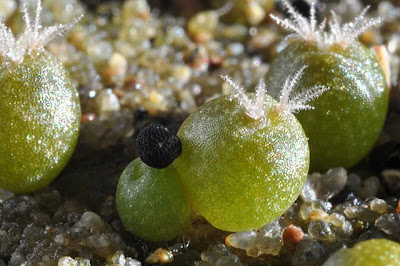
Lophophora williamsii seedlings (VM 534k; El Oso, Coahuila, Mexico)
I'm growing my Lophophora, Obregonia, Acharagma, Ariocarpus and Strombocactus in more or less the same way (Strombocactus being the exception).
Growing medium
Till now I've used a finer compost for sowing but this year I decided trying to sow in the same growing medium I'm using for my mature (limestone-loving) plants, i.e. equal parts of:
- Coarse, loamy sand
- Limestone gravel
- Milled sphagnum moss peat
Sowing
The seeds are placed individually (using a moist toothpick) directly on the surface of the compost and not covered. The pot is then sprinkled lightly with water and placed in a plastic bag with a bit of water at the bottom. Finally the bag is sealed closely and placed in a heated windowsill.
Hardening off seedlings
When most of the seed have germinated and the seedlings are well established it is time to introduce them to the harsh world (usually 4-5 weeks after sowing - but Strombocactus should be left considerably longer). This is done by puncturing the sealed bag to make the “atmosphere” less humid. The punctures are gradually expanded until the bag can be completely removed after 1-2 weeks. Until the roots are well established the seedlings must not be left dry for extended periods - this winter I almost killed off last years stock of Lophophora fricii seedlings by leaving them dry for 5 weeks!
Links
The British Cactus and Succulent Society has a page on how to grow cacti and other succulent plants from seed. Steve Brack's Mesa garden has a list of basic germination tips.
Cactus seed and plant retailers
Below is a list of retailers/nurseries selling cactus seed and plants. I've only listed vendors I've done business with.
If you are looking to buy peyote seeds or plants, please check your local laws before doing so. All parts of peyote (Lophophora williamsii) plants and the seeds thereof are classified as Schedule I substances in the United States. Also, peyote is illegal to posses in France, Russia, and possibly more countries.
Seeds
Jan Martin Jecminek has a lot of different seed. Many with locality information.
Another Czech seed retailer is Chrudimsky kaktusar. They are also selling plants. The germination rate of Pavel Pavlicek's seed is incredibly high.
Yet another Czech vendor is Jaromír Dohnalík (the Czechs are big in the cacti business).
Kaktusy Ryšavý has many different Lophophora seeds with locality information (and is by coincidence also Czech ;-).
If you can't find the seeds you're looking for at Steve Brack's Mesa Garden, you probably can't find it anywhere (except peyote seeds - illegal in the USA).
Köhres-Kakteen also have a large selection of cactus seeds - you can find their Lophophora seeds on their general cactus seed list (offering thousands of different varieties of cacti) or have a look at the dedicated "peyote seed list" found at Lophophora.info.
Navajo Country - Pediocactus, Sclerocactus, Navajoa, Toumeya and other hardy cacti.
Plants
Mesa Garden, Uhlig-Kakteen, Kakteen-Haage, and Albert Plapp all have huge selections of plants.
The German retailer Kakteen Kliem has a good selection of plants with locality information.
Affiliate Links

Seedlingservice.com (also by CactusPlaza) offers healthy and naturally grown seedlings of cacti and other succulents.

Grafting stock
Allies (formerly ...of the jungle) carries a good selection of Trichocereus cuttings (I bought Trichocereus 'Juul's Giant'). The people at Allies are extremely helpful and friendly, and their cuttings are healthy and good value.

All Time Most Popular Posts
-
Lophophora williamsii (peyote) populations have diminished in large areas of South Texas where peyoteros harvest the cactus for ceremonial ...
-
On various occasions I've been asked what growing media I'm using for my cactus plants. I don't have a set soil mix recipe as su...
-
Below is a list of retailers/nurseries selling cactus seed and plants. I've only listed vendors I've done business with. If you ar...
-
Most cacti are easily grown from seed - and with a little patience and care they can be grown into beautiful plants. Lophophora williamsi...
-
In last month’s post on the troubled Texan peyoteros I referred to Anderson’s article on the peyote situation in Texas. Given the importanc...
-
Yet another slightly off topic and probably not entirely politically correct post, but I couldn’t help noticing the similarity of my monstr...
-
Flowering stand of San Pedro cacti (Trichocereus pachanoi) To me the main draw of the San Pedro cactus ( Trichocereus pachanoi (syn. Ech...
-
In the June 2008 issue of the Cactus & Co magazine Jaroslav Šnicer, Jaroslav Bohata, and Vojtěch Myšák described a new Lophophora spec...
-
There seems to be an increased focus on the alarming Texas peyote situation. A couple of weeks ago the Houston Press published a mournful, i...
-
I spent two weeks working in Delhi, India during January. I had one weekend off and had planned to spend it in Delhi at my own leisure, but ...


















